
Sheep farming or sheep husbandry is the raising and breeding of domestic sheep. It is a branch of animal husbandry. Sheep are raised principally for their meat, milk, and fiber (wool). They also yield sheepskin and parchment.

The Blackface or Scottish Blackface is a British breed of sheep. It is the most common sheep breed of the United Kingdom. Despite the name, it did not originate in Scotland, but south of the border.

The Coopworth is a modern New Zealand breed of sheep. It was developed by researchers at Lincoln College in the Canterbury region of the South Island between about 1956 and 1968, the result of cross-breeding of New Zealand Romney ewes and Border Leicester rams. It has become the second-most numerous sheep breed in New Zealand, and has been exported to Australia, some European countries, and the United States.
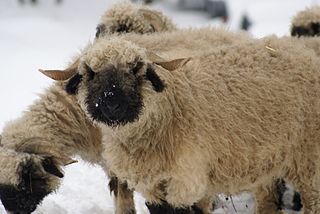
The Valais Blacknose, German: Walliser Schwarznasenschaf, is a breed of domestic sheep originating in the Valais region of Switzerland. It is a dual-purpose breed, raised both for meat and for wool.

The Jacob is a British breed of domestic sheep. It combines two characteristics unusual in sheep: it is piebald—dark-coloured with areas of white wool—and it is often polycerate or multi-horned. It most commonly has four horns. The origin of the breed is not known; broken-coloured polycerate sheep were present in England by the middle of the seventeenth century, and were widespread a century later. A breed society was formed in 1969, and a flock book was published from 1972.

The Suffolk is a British breed of domestic sheep. It originated in the late eighteenth century in the area of Bury St. Edmunds in Suffolk, as a result of cross-breeding when Norfolk Horn ewes were put to improved Southdown rams. It is a polled, black-faced breed, and is raised primarily for its meat. It has been exported to many countries, and is among the most numerous breeds of sheep worldwide.

The Barbados Black Belly is a breed of domestic sheep from the Caribbean island of Barbados. It is raised primarily for meat. Unlike most tropical sheep, it is highly prolific, with an average litter size of approximately 2.

The Oxford Down is a British breed of domestic sheep. It was developed in the 1830s by cross-breeding of Hampshire Down and Southdown ewes with Cotswold rams. It is reared primarily for meat.

The Southdown is a British breed of domestic sheep, the smallest of the British breeds. It is a shortwool breed, and the basis of the whole Down group of breeds. It was originally bred by John Ellman of Glynde, near Lewes in East Sussex, in about 1800. It has been exported to many countries; it has been of particular importance in New Zealand, where it was used in the breeding of Canterbury lamb. In the twenty-first century it is kept principally as a terminal sire.
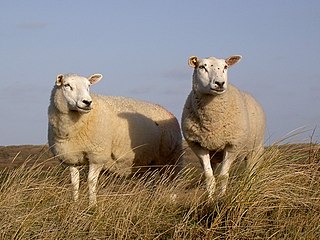
The Texel is a Dutch breed of domestic sheep originally from the island of Texel. It is a heavy and muscular sheep, and produces a lean meat carcass. It is polled, clean-faced and clean-legged, with white face and wool. The fibre diameter of the wool averages about 32 μ, with a staple length of 8–15 cm; it is used mainly for knitting and hosiery wools.
The Easycare or Easy Care is a modern British breed of easy-care sheep. It was developed in Wales in the second half of the twentieth century by cross-breeding between Welsh Mountain and Wiltshire Horn stock, with the aim of combining the meat-producing qualities and natural moulting characteristic of the latter with the hardiness of the former. It is reared for meat production.
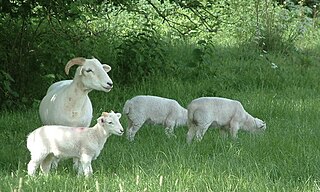
The Wiltshire Horn is a breed of domestic sheep originally from Wiltshire in southern England raised for meat. The breed is unusual among native British breeds, for it has the unusual feature of moulting its short wool and hair coat naturally in spring, obviating the need for shearing. They are good mothers and have high fertility.

The St Croix is a breed of domestic sheep native to the U.S. Virgin Islands and named for the island of Saint Croix. They are often also called Virgin Island White because those that were imported into North America were selected for white coloration. On the Island of St. Croix, they come in shades of brown, white, and black.
The White Suffolk is a modern Australian breed of domestic sheep. It was bred from 1977 to have the meat-producing qualities of the Suffolk, but without the typical black markings.
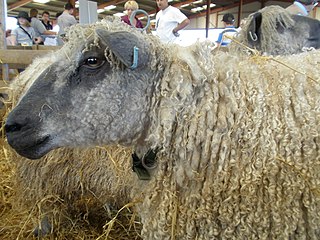
The Wensleydale is a British breed of domestic sheep. It is named for the Wensleydale region of North Yorkshire, in the north of England, where it was bred in the early nineteenth century by cross-breeding a Dishley Leicester ram with local long-woolled sheep of a breed that is now extinct. It has a blue-grey face and long purled wool, and is among the heaviest of British sheep breeds. It is an endangered breed, and is categorised as "at risk" by the Rare Breeds Survival Trust. It is often used as a ram breed to cross with other breeds to obtain market lambs, and for its high-quality wool.

The Boreray, also known as the Boreray Blackface or Hebridean Blackface, is a breed of sheep originating on the St Kilda archipelago off the west coast of Scotland and surviving as a feral animal on one of the islands, Boreray. The breed was once reared for meat and wool, but is now used mainly for conservation grazing. The Boreray is one of the Northern European short-tailed sheep group of breeds.
The Devon Closewool is a British breed of domestic sheep. It is distributed almost exclusively on Exmoor in North Devon, in south-west England. It is raised primarily for meat.
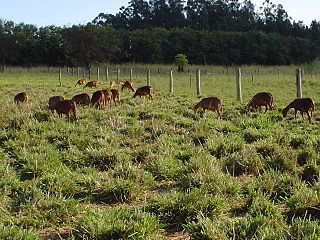
Morada Nova is a Brazilian breed of domestic sheep. It originates in the state of Ceará, in Nordeste, the north-eastern region of Brazil, on the Atlantic coast.

The Charmoise is a French breed of domestic sheep. It was created in the early nineteenth century by Édouard Malingié, by cross-breeding of Romney stock imported from the United Kingdom with local breeds including the Berrichon du Cher, Merino, Solognote and Tourangelle. It is reared for both meat and wool. Breed numbers fell from a peak of approximately 650000 in the 1960s to about 122000 in 1983, to approximately 21000 in 2001, and further to 8100 in 2014.

The Rideau Arcott is a breed of domestic sheep native to Canada, one of only a few livestock breeds native to the country.


















